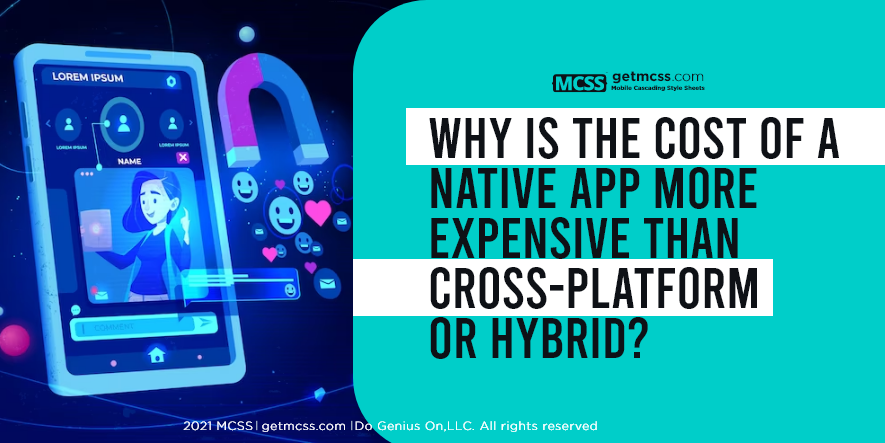When it comes to mobile app development, businesses often face the dilemma of choosing between native app development and cross-platform or hybrid app development. While native apps are known for their high performance and seamless user experience, they tend to be more expensive to develop compared to hybrid apps. In this article, we will explore the reasons behind the higher costs of native app development and how using a low-code framework like MCSS (Mobile Cascading Style Sheets) can help reduce those costs.
1. Why a Native App has higher costs compared to other hybrid technologies
1.1 Separate Development for Android and iOS
One of the main reasons native app development is more expensive is that it requires separate development for Android and iOS platforms. Developers need to write separate codebases in different programming languages (Java/Kotlin for Android and Swift/Objective-C for iOS), which increases the development time and effort.
1.2 Platform-Specific UI/UX Design
Native app development requires platform-specific UI/UX design to ensure the app adheres to each platform's design guidelines. This means that designers need to create separate designs for Android and iOS, further adding to the development costs.
1.3 Maintenance and Updates
Maintaining and updating native apps can be more costly, as each platform's codebase needs to be updated separately. Additionally, platform updates and new device releases might require code changes to ensure compatibility, further increasing the maintenance costs.
1.4 Skilled Developers
Native app development demands specialized skills in platform-specific programming languages and tools. Skilled developers who have expertise in both Android and iOS development can be scarce and more expensive to hire compared to hybrid app developers who can work with a single codebase.
2. Cost Comparisons: Native vs Hybrid App Development
Native app development refers to building applications specifically for a single platform, such as iOS or Android, using their respective programming languages and tools. Hybrid app development, on the other hand, involves creating applications using web technologies like HTML, CSS, and JavaScript, which can then be wrapped in a native container for deployment on multiple platforms.
Small projects:
-
Native: The cost of native app development for small projects can vary significantly depending on the complexity of the app and the expertise of the developers. Generally, native development for small projects can range from $10,000 to $50,000 per platform.
-
Hybrid: Hybrid app development for small projects is typically more cost-effective, with costs ranging from $5,000 to $25,000. This is because a single codebase can be used to target multiple platforms, reducing the overall development effort.
Medium projects:
-
Native: For medium-sized projects with more complex features, native app development can range from $50,000 to $150,000 per platform.
-
Hybrid: Hybrid app development costs for medium projects can range from $25,000 to $75,000, still maintaining a cost advantage due to the ability to share code across platforms.
Large projects:
-
Native: Large projects with complex requirements and features can see native app development costs ranging from $150,000 to $500,000 or more per platform.
-
Hybrid: For large projects, hybrid app development costs can range from $75,000 to $250,000 or more.
It's important to consider that these costs are rough estimates and can vary widely based on factors such as the geographic location of the development team, the specific requirements of the project, and the chosen technology stack.
The choice between native and hybrid app development depends on factors beyond cost, such as the desired user experience, performance, and available resources.
3. Factors to consider when choosing a technology.
A key factor when choosing either of the two, is the experience of the team on the chosen technology.
Remember also that hybrid technologies, will always be one step below native technologies.
Hybrid technologies today are many, but the question arises, how many of these will remain over time?. If a technology is chosen that fails to survive over time, the company will most likely have to invest in a new development.
But if you choose native technologies you are playing it safe.
4. Lowering Native App Development Costs with MCSS Framework
The MCSS (Mobile Cascading Style Sheets) framework is a low-code solution that can help reduce the costs of native app development while maintaining high performance and user experience. Here are some ways MCSS can help lower costs:
4.1 Faster Development Time
MCSS allows developers to quickly build native apps using reusable components and patterns, which reduces the development time and, subsequently, the overall cost.
4.2 Simplified UI/UX Design
The MCSS framework comes with a set of pre-built UI components that adhere to both Android and iOS design guidelines. This simplifies the UI/UX design process and reduces the time and effort required to create platform-specific designs.
4.3 Efficient Maintenance and Updates
With MCSS, maintaining and updating native apps is more manageable, as the framework ensures consistent behavior and appearance across platforms. This reduces the effort needed to maintain separate codebases for Android and iOS.
4.4 Reduced Learning Curve
Developers using the MCSS framework can leverage their existing web development skills, such as HTML, CSS, and JavaScript, reducing the learning curve for native app development.
Conclusion
Native app development is often more expensive than hybrid app development due to separate development for each platform, platform-specific UI/UX design, skilled developers, and maintenance costs. However, using a low-code framework like MCSS can help reduce the costs of native app development while still delivering high-quality apps with excellent performance and user experience.
References
Home. (n.d.). YouTube. Retrieved April 17, 2023, from https://powerapps.microsoft.com/en-us/native-vs-cross-platform-apps

